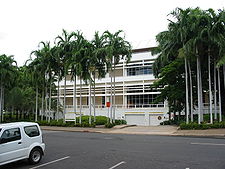- Supreme Court of the Northern Territory
-
Supreme Court of the Northern Territory 
Established 30 May 1911 Jurisdiction  Northern Territory,
Northern Territory,  Australia
AustraliaLocation Darwin Coordinates 12°28′00″S 130°50′38″E / 12.46675°S 130.843936°ECoordinates: 12°28′00″S 130°50′38″E / 12.46675°S 130.843936°E Composition method appointed by the Administrator Decisions are appealed to High Court of Australia Judge term length mandatory retirement by age of 70 Number of positions 6 Website www.supremecourt.nt.gov.au Chief Justice of the Northern Territory. Currently Trevor Riley Since 27 September 2010 The Supreme Court of the Northern Territory is the superior court for the Australian Territory of the Northern Territory. It has unlimited jurisdiction within the territory in civil matters, and hears the most serious criminal matters. It is around the middle of the Australian court hierarchy.
Contents
Early history
Shortly after the first settlement at Palmerston, Port Darwin in 1869-70, pressure was placed upon the South Australian government to establish a superior court in the then Northern Territory of South Australia. Although such a court was mooted, it was decided to send judges to Palmerston on circuit. The first circuit court was held in February 1875. [1]
Thereafter, from 1875 to 1884, the government appointed persons as commissioners (usually the Government Resident) to exercise the power of a judge of the Supreme Court in all but trials of capital offences.
From 1884 to 1911, a resident judge, with the title "Judge of the Northern Territory" exercised the full powers of the Supreme Court under the Northern Territory Justice Act.
History
The court was established on 30 May 1911, shortly after South Australia surrendered the territory to the Commonwealth. The first judge of the court was Samuel James Mitchell. The only person to hold the office of Chief Judge, which was created in 1975, was Sir William Forster who held the position from 1977-1979. The position title was changed to Chief Justice in 1979, and Forster was the first Chief Justice from 1979-1985. There have been 6 Chief Justices since 1979 [2]. There are currently six resident judges (including the Chief Justice) and two additional judges and two acting judges, making a total of ten Supreme Court justices. [3]
In 1927, when the Northern Australia 1926 Act (Cth) came into force, the Northern Territory was divided into two territories; North Australia and Central Australia. The Supreme Court was not abolished, but continued to exist as the Supreme Court of North Australia and the Supreme Court of Central Australia.
After the Northern Territory Act was repealed in 1931, the Northern Territory was reconstituted as a single Territory of the Commonwealth. The Supreme Courts of North Australia and Central Australia were abolished and the Supreme Court continued as the Supreme Court of the Northern Territory. In 1935 the Court began its first sittings on circuit in Alice Springs [4], a practice which still continues today. Circuit sittings in Katherine were also introduced in 1996.
When a new Supreme Court complex was built, Indigenous artist Norah Nelson Napaljarri was chosen to design a mosaic for its forecourt.[1] The design concept of the Supreme Court, as requested by the client the Northern Territory Government, was to reflect the elements of the "Greek Revival" Hong Kong Shanghai Bank constructed in Hong Kong in the 1800's viz: the colonnade around the building, the mansard roof and the portico entrance as well as giving reference to it's tropical location and it's colonial past. The collaborating architects were Peter Doig, Ron Findlay and Roger Linklater: the interior was designed by Susie Cole. The architectural style is best described as Neo-colonial.
Other
The Supreme Court occasionally sits in other locations in the Northern Territory, including Katherine, Tennant Creek and Nhulunbuy. The Supreme Court has also on occasion sat at remote aboriginal communities.
The Supreme Court includes the Court of Appeal, Court of Criminal Appeal, Civil and Criminal Trials and Appeals from the Northern Territory Magistrates Court. [5]
Judgments from Supreme Court trials are available to the public [6], as are the sentencing remarks [7], unless a suppression order has been taken preventing these being released (for example, involving juveniles, public figures or in some controversial matters).
Judges of the Supreme Court of the Northern Territory
As at April 2010 (appointment date in brackets):
Chief Justice
Name Date appointed Chief Justice Trevor Riley 27 September 2010 Judges
Name Date appointed Justice Dean Mildren 27 June 1991 Justice Stephen Southwood 31 January 2005 Justice Judith Kelly 12 August 2009 Justice Jenny Blokland 9 April 2010 Justice Peter Barr 30 September 2010 Additional Judges
Name Date appointed John Reeves May 2009 John Mansfield June 2009 Brian Ross Martin November 2010 Acting Judges
Name Date appointed Acting Justice Trevor Olsson 6 July 2004 Master
Name Date appointed Vince Luppino 2009 See also
- Family Court of Australia
- Federal Court of Australia
- Judiciary of Australia
- List of Judges of the Supreme Court of the Northern Territory
References
External links
Government of the Northern Territory Executive 
Legislative Judicial High Court • Supreme Court • Magistrates' Court • Local Court • Coroners Court • Other courts and tribunalsCourts of the Australian states and territories Commonwealth High Court · Federal Court · Family Court · Federal Magistrates Court · Military Court of Australia · List of Commonwealth courts and tribunalsNew South Wales Victoria Queensland Western Australia South Australia Tasmania Australian Capital Territory Northern Territory Norfolk Island Categories:- Australian appellate courts
- Supreme Court of the Northern Territory
- Buildings and structures in Darwin
Wikimedia Foundation. 2010.
